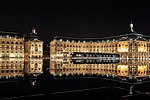Place des Quinconces

The Place des Quinconces, located in Bordeaux, France, is among the largest city squares in Europe (approximately 63 ac or 25.6 ha). It was laid out in 1820 on the site of Château Trompette and was intended to prevent rebellion against the city. Its guns were turned towards the centre. Its current shape (lengthened rectangle rounded off with a semicircle) was adopted in 1816. Trees were planted (in quincunxes, hence the name of the square) in 1818. With the installation of a tram system in 2003, the place has become the most important public transport hub of the area, with Quinconces tram stop serving three tram lines, 21 bus lines (including 3 night buses), an electric shuttle, and 12 coach lines through Gironde as well as a reception area in the south.
Excerpt from the Wikipedia article Place des Quinconces (License: CC BY-SA 3.0, Authors, Images).Place des Quinconces
Allées de Bristol, Bordeaux Quinconces
Geographical coordinates (GPS) Address Website External links Nearby Places Show on map
Geographical coordinates (GPS)
| Latitude | Longitude |
|---|---|
| N 44.845555555556 ° | E -0.57361111111111 ° |
Address
Esplanade des Quinconces
Allées de Bristol
33000 Bordeaux, Quinconces
Nouvelle-Aquitaine, France
Open on Google Maps










